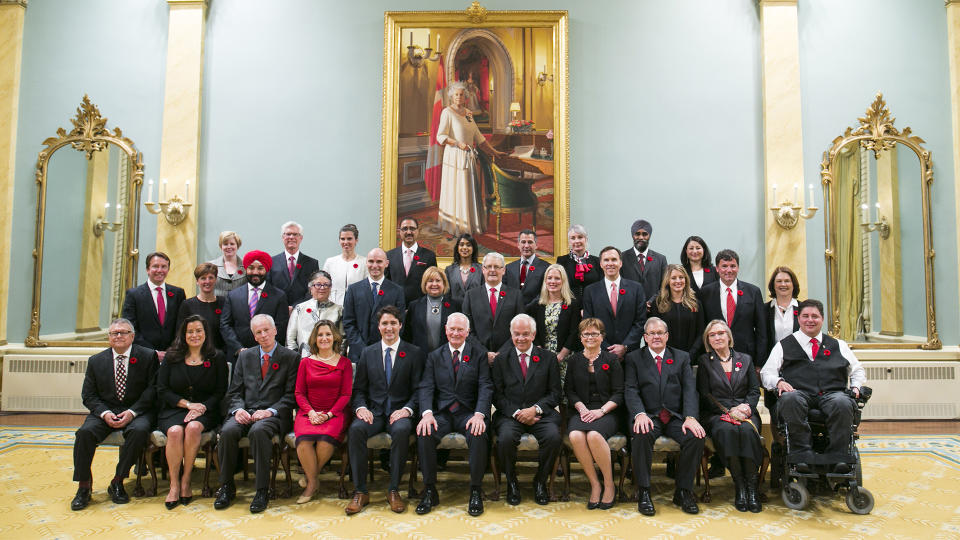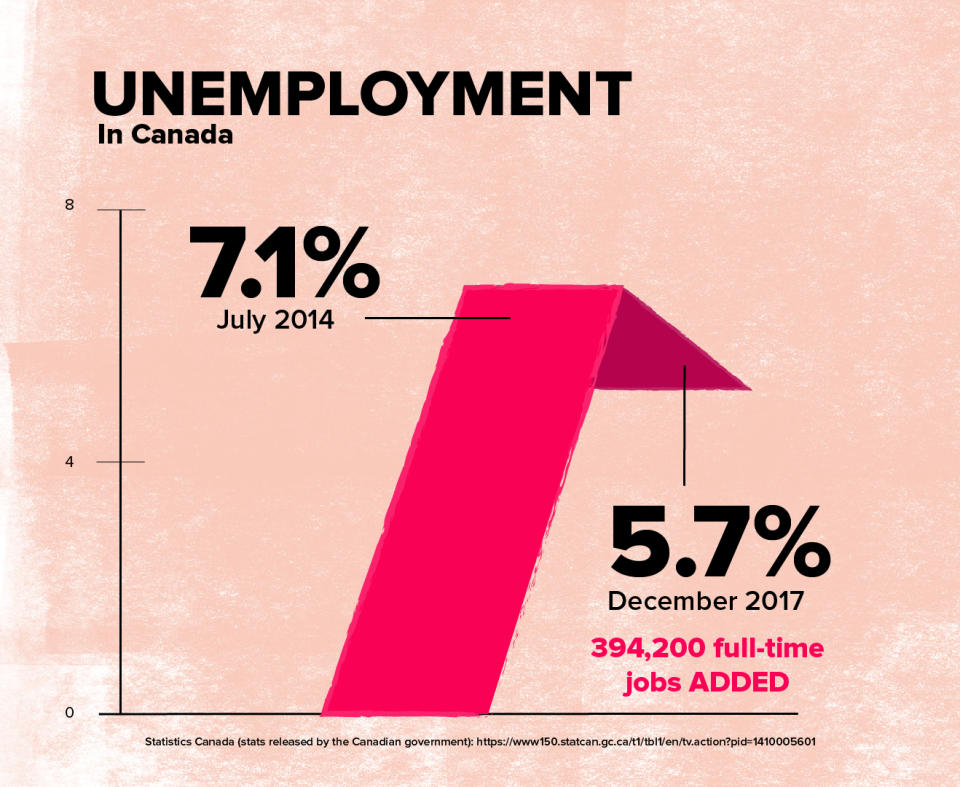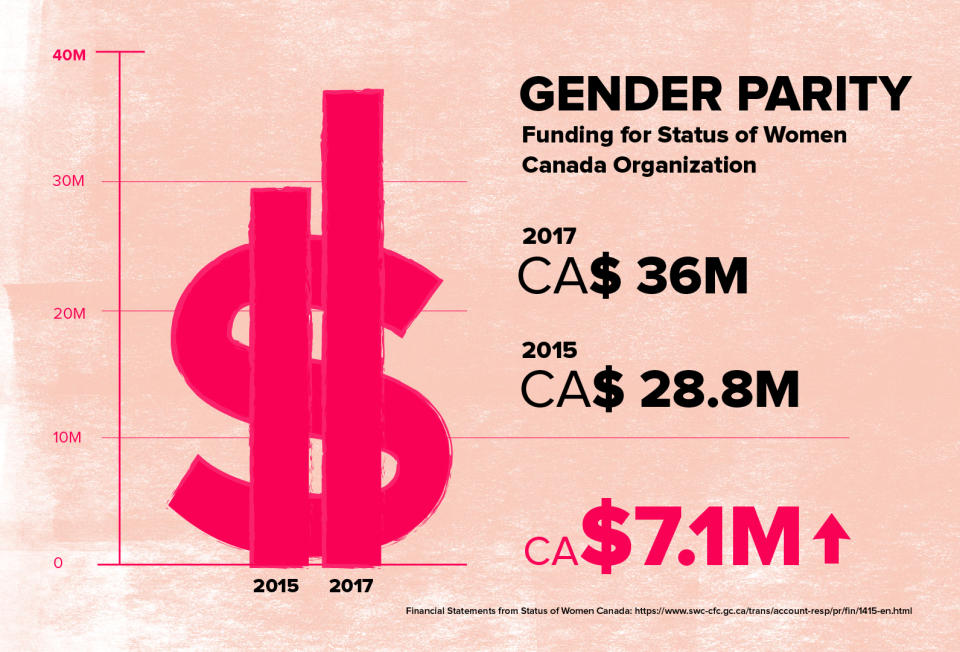The Justin Trudeau effect: what happens when leaders put more women in power
In our series Leaders We Love, MAKERS highlights the work of world leaders who show how a commitment to equality, humanity, and inclusivity results in real change.
On November 4, 2015, Canadian Prime Minister Justin Trudeau started his term with a bold move and showed the world what it looked like to lead like a feminist.
He named more women to key roles in his administration than any other in the country's history—half to be exact. With a cabinet that "looks like Canada," the self-proclaimed feminist leader counts 15 women, two Canadian aboriginals, and five people of color as part of his administration.

This marks a sharp liberal left turn from his conservative predecessor who only had six female ministers and zero members of aboriginal descent.
When asked why he wanted a gender-balanced cabinet, the newly minted Prime Minister simply replied, "Because it's 2015."
Well, it's now 2018, and nearly three years later we were wondering, what really happens when you let girls (and feminists!) run the world?
America, take notes.
Gross Domestic Product

Before Trudeau's feminist administration came to power, Canada's gross domestic product (GDP) fell by .2% to $1,559 billion U.S. dollars in 2015, after factory manufacturing slowed and mining and energy sectors experienced record declines.
Then, feMANist Minister of Finance Bill Morneau and Minister of International Trade Chrystia Freeland (who held the role from 2015 to 2017 until she was named Minister of Foreign Affairs) took over. Trudeau and Morneau instituted changes such as tackling the issue of gender equality in the workplace through Canada's national budget. Since then, Canada's gross domestic product (GDP) has increased by $93 billion USD in two years, grossing US$1,653 billion in 2017.
Health Care
Health care remains a hotly debated topic in Canada that circles around how much the government can and should pay and what exactly is covered. For Minister of Health Jane Philpott, the answer to both questions has been to cover as much as possible. According to the Canadian Institute for Health Information, Canada's health care spending per capita was $6,045 Canadian dollars in 2014. In other words, health spending represented 11 percent of Canada's GDP.
During Philpott's time as Minister of Health, by 2017, Canada was spending CA$6,603 per capita on health care or 11.5 percent of Canada's domestic gross product. (With Canada's GDP even higher in 2017 than 2014, that means even more money!)
Unemployment

Hard hit by a recession and a slow recovery, Canada's unemployment rate in 2014 was near a historic all-time high at 7.1 percent. However, Minister of Employment Workforce, Development and Labour MaryAnn Mihychuk—who was recently replaced by Patty Hajdu—turned a period that what was nearing rock bottom for the workforce into an era of growth and prosperity. By December 2017, Canada's overall unemployment rate dropped to 5.7 percent—the lowest in more than 40 years. In 2017 alone, the nation added 394,200 full-time jobs.
Climate Change
In 2014, emissions from mining and upstream oil and gas production were more than twice their 1990 values with an estimated 263.95 megatonnes of greenhouse gas emissions (GHGs) from 577 facilities. On average, a single facility was producing an average of 457,000 tonnes of GHGs.
With the appointment of Minister of Environment and Climate Change Catherine McKenna, Canada recommitted its efforts to move toward a low-carbon economy. McKenna helped implement the Pan-Canadian Framework on Clean Growth and Climate Change, the country's green action plan with over 50 measures to reduce greenhouse emissions. She also spearheaded efforts to promote the clean-technology sector business with China. By 2016, only 263.25 megatonnes of greenhouse gas emissions were reported from 596 facilities— that's an average of 441,000 tonnes of GHGs. In other words, the country was able to increase its productivity and manufacturing without increasing its carbon footprint.
Gender Parity

Justin Trudeau ushered in an era of inclusivity not only with his diverse and gender-balanced cabinet but with his dedication to ensuring Canadian women were treated equally. With the help of Minister of Finance Bill Morneau, Trudeau passed the Action Plan on Gender-Based Analysis, a framework that "sets goals and timelines for fully implementing, evaluating and resourcing gender-based analysis across the federal government."
The previous administration had slashed funds for the Status of Women Canada—the federal government organization that advances equality for women—by nearly CA$2 million, with the total spending in 2015 at CA$28,788,249. Nevertheless, they persisted and benefited from Trudeau's feminist ministerial team. By 2017, the Status of Women Canada's budget was approximately CA$36 million.
And to top that, Morneau announced it would be increasing its funding for the Women's Program which provides funding to organizations at all levels that tackle violence against women, women's economic prosperity, and uplifting women in leadership roles under the Status of Women Canada. The Women's Program funding is now set at a whopping CA$40 million per year.
Immigration
Prior to Trudeau's 2015 inauguration, the previous prime minister had moved away from Canada's multilateral policies and its support of the United Nations and moved towards bolstering national security and focusing inward. While the civil unrest in Syria created one of the biggest global refugee crises, Canadian officials only admitted 23,285 refugees in 2014.
When he took office in November 2015, Trudeau took a 180-degree stance on the isolationist policy with a pledge to accept 25,000 Syrian refugees with open arms, appointing Minister of Health Jane Philpott to oversee the government resettlement efforts. Under the advisement of Philpott, Canada exceeded their goal and accepted 46,700 refugees by the end of 2016, a record since 1980.

